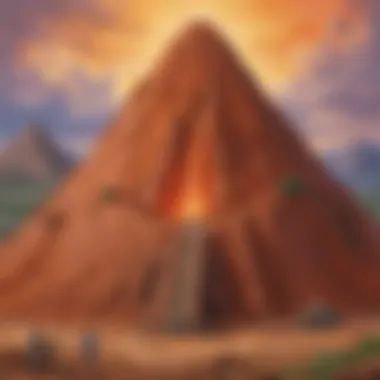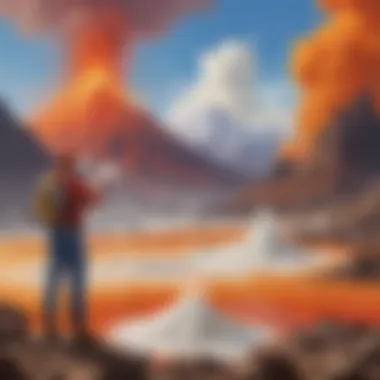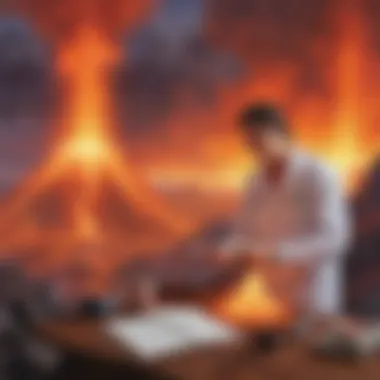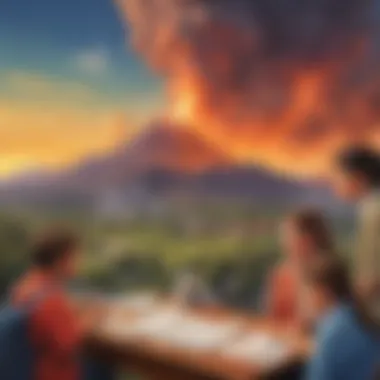Unleashing the Wonders: Materials for an Engaging Volcano Project


Science Fun Facts
Begin your journey into the fascinating world of volcanoes with some captivating science trivia and quirky facts. Did you know that the word 'volcano' originates from Vulcan, the Roman god of fire? It's intriguing to learn that the largest volcano in our solar system is not on Earth but on Mars; Olympus Mons dominates the Martian landscape, standing tall at over 13 miles high.
Discover the Wonders of Science
Dive deeper into the realms of science as we explore various scientific concepts related to volcanoes. Watch engaging educational videos and animations showcasing volcanic eruptions in real-time. Discover how scientists use seismographs to monitor volcano activity and predict eruptions, showcasing the practical applications of scientific knowledge.
Science Quiz Time
Engage in an interactive quiz session to test your knowledge on volcanoes. Answer multiple-choice questions on topics ranging from magma composition to eruption types. Challenge yourself with brain teasers such as identifying famous volcanic landmarks worldwide. Learn through gamification as you uncover the mysteries behind volcanic phenomena.
Science Experiment Showcase
Get ready for a hands-on volcanic adventure with fun and engaging experiments. Follow step-by-step instructions to create your volcano model using simple household materials. Prepare your materials list, including baking soda, vinegar, and food coloring for a colorful eruption effect. Prioritize safety with tips on handling chemicals and setting up a secure experiment space to enjoy a safe and exciting learning experience.
Introduction
The foundation of any scientific pursuit lies in a thorough understanding of its core concepts. When embarking on a journey to explore the fascinating realm of volcanoes, it becomes paramount to grasp the fundamental principles underlying these natural wonders. The introduction section serves as a gateway into the captivating world of volcanic activity, setting the stage for a comprehensive exploration of volcano projects. By delving into the basic mechanisms that drive volcanic eruptions and the significance of studying these geological phenomena, young minds are primed to engage with the subsequent sections with a sense of curiosity and wonder.
Understanding Volcanoes


To comprehend the essence of volcanoes is to unravel the mysteries of the Earth's inner workings. Within the realm of geology, volcanoes stand as monumental symbols of the planet's dynamic processes, embodying both destructive power and creative force. Understanding volcanoes involves examining the geological processes that give rise to these majestic structures, from the magma that simmers beneath the Earth's crust to the eruptive events that shape landscapes. By illuminating the intricate interplay of tectonic plates, magma chambers, and volcanic gases, young learners gain a deeper appreciation for the forces that have shaped our planet's evolving landscape.
Importance of Volcano Projects
The importance of volcano projects transcends mere academic exercises; it offers a hands-on, immersive experience that bridges theoretical knowledge with practical application. Engaging in volcano projects allows young scientists to apply their understanding of volcanic processes in a tangible and interactive manner. By constructing model volcanoes and simulating eruptions using household materials, participants gain insight into the scientific method, hypothesis testing, and data collection. Beyond the scientific realm, volcano projects foster creativity, critical thinking, and a deeper connection to the natural world. Through hands-on experimentation, young learners not only expand their scientific horizons but also cultivate a sense of wonder and curiosity towards the mysteries of the Earth's geological phenomena.
Volcano Project Materials play a vital role in the creation and execution of a successful scientific experiment. By meticulously selecting the right materials, participants can enhance the overall experience and achieve accurate results. In this section, we will delve into the various elements comprising Volcano Project Materials, highlighting their significance and practical applications.
Building the Volcano Structure
- Cardboard: Cardboard stands as a fundamental material in crafting the base structure of a volcano. Its lightweight composition and sturdy nature make it an ideal choice for constructing the initial framework. The malleability of cardboard allows for easy shaping and customization. One must ensure the cardboard is free from moisture to maintain structural integrity throughout the experiment.
- Plaster of Paris: Plaster of Paris contributes to the durability and texture of the volcano structure. Its quick-drying properties enable participants to mold intricate details with ease. The smooth finish achieved with plaster of Paris adds a realistic touch to the overall appearance of the volcano. However, note the importance of handling the plaster carefully due to its powdery nature.
- Newspaper: Newspaper serves as a cost-effective and eco-friendly material for reinforcing the layers of the volcano. The absorbent nature of paper helps in creating a solid foundation while enabling participants to add layers for desired thickness. A key advantage of using newspaper is its availability and ease of disposal after the project is completed.
- Paint: Paint is essential for adding color and depth to the volcano structure. Participants can unleash their creativity by selecting suitable hues to mimic the appearance of real volcanic rocks. However, it is crucial to allow sufficient drying time between paint layers to prevent smudging and ensure a professional finish.
Selection of Eruption Materials
- Vinegar: Vinegar plays a pivotal role in creating the volcanic eruption effect. Its acidic nature reacts with other materials to produce fizzing and bubbling, mimicking the release of volcanic gases. The controlled reaction achieved with vinegar adds a dramatic element to the experiment, captivating participants with its explosive results.
- Baking Soda: Baking soda serves as the primary source of the volcanic eruption. When combined with vinegar, it undergoes a chemical reaction that generates the bubbling action indicative of an eruption. The ease of access and safe handling of baking soda make it a popular choice for conducting engaging and interactive demonstrations.
- Red Food Coloring: Red food coloring enhances the visual appeal of the eruption by imparting a realistic lava-like hue to the mixture. Its vivid coloration creates a striking contrast against the neutral tones of vinegar and baking soda, intensifying the overall eruption effect.
- Dish Soap: Dish soap aids in creating foaming and frothing effects during the eruption process. By introducing dish soap into the vinegar and baking soda mixture, participants can simulate the flowing movement of lava. The addition of dish soap adds an element of visual interest and dynamic motion to the experiment.
Safety Equipment
- Safety Goggles: Safety goggles are essential for protecting the eyes from any potential splashes or fumes during the volcanic eruption. Their role in ensuring participant safety cannot be overstated, emphasizing the importance of wearing proper eye protection throughout the experiment.
- Gloves: Gloves provide a barrier against direct contact with eruption materials, guarding the skin from irritation or allergic reactions. Participants must choose non-latex gloves to accommodate potential allergies and ensure a comfortable experience while handling the experiment.
- Apron: An apron shields participants' clothing from accidental spills or stains during the eruption process. Its durable fabric and adjustable ties offer secure coverage, allowing participants to engage in the experiment with peace of mind. The apron serves as a practical accessory to maintain cleanliness and protect clothing throughout the scientific endeavor.
Setting Up the Experiment


When it comes to conducting a volcano project, the setting up of the experiment plays a pivotal role in ensuring the success and educational value of the activity. It allows young minds to delve into the realms of scientific inquiry, igniting their curiosity and fostering a hands-on approach to learning. While seemingly a simple task, the process of setting up the experiment encompasses a range of crucial elements that contribute to the overall charm and learning experience inherent in such projects. From understanding the structural integrity of the volcano to the chemical reactions that unfold during the eruption, setting up the experiment serves as the foundation upon which scientific exploration thrives.
Assembly of the Volcano
Step 1: Constructing the Base
In the intricate process of constructing the volcano base, attention to detail and precision are key. The base serves as the literal groundwork for the entire structure, providing stability and support for the impending eruption. Utilizing sturdy materials like cardboard and plaster of Paris, participants can craft a robust foundation capable of withstanding the explosive forces within. The meticulous construction of the base not only ensures the structural integrity of the volcano but also offers a hands-on experience in spatial reasoning and design principles.
Step 2: Shaping the Volcano
As participants move on to the shaping phase, creativity and imagination come into play. Shaping the volcano allows individuals to breathe life into their geological masterpiece, molding it to reflect the raw beauty of a real volcano. Whether opting for a stratovolcano or a shield volcano design, this step encourages young scientists to explore the diverse forms that volcanic structures can take. The act of shaping the volcano not only enhances artistic expression but also deepens understanding of geological processes and landform development.
Step 3: Painting the Volcano
The final touch in the assembly process involves adding color and texture to the volcano. Painting the volcano not only adds aesthetic appeal but also serves a functional purpose in highlighting the various layers and rock compositions present. Participants can unleash their artistic talents by recreating the fiery hues of flowing lava or the lush greenery of surrounding landscapes. Beyond visual appeal, painting the volcano allows for discussions on geological stratigraphy and the compositional diversity found in volcanic regions.
Preparing the Eruption
Step 1: Adding Ingredients
An essential aspect of the eruption preparation is the meticulous measurement and mixing of eruption ingredients. From vinegar to baking soda and red food coloring, each element plays a crucial role in simulating the explosive chemistry of a volcanic eruption. Careful consideration must be taken in the proportions and sequence of ingredient addition to achieve an exciting and safe volcano eruption. This step not only highlights the principles of chemical reactions but also emphasizes the significance of precision in scientific experimentation.


Step 2: Creating the Eruption Effect
The grand finale of the volcano project lies in creating the eruption effect. As participants combine the prepared ingredients within the volcano structure, the anticipation builds for the climactic moment of eruption. The chemical reaction between the added ingredients results in a bubbling, fizzing eruption that mimics the explosive nature of a real volcano. Observing this eruption effect not only delights participants but also reinforces the scientific concepts of pressure buildup and gas release in volcanic activity.
Conducting the Volcano Eruption
Conducting the Volcano Eruption is a crucial stage in any volcano project. This section focuses on turning your well-crafted volcano model into a dynamic and enthralling scientific demonstration. The eruption itself serves as the climax of the project, where all the preparation culminates in a visually stimulating and educational experience for both the creator and the audience. Observing the volcanic eruption in action provides a practical understanding of geological processes and ignites curiosity in young minds.
To conduct a successful volcano eruption, several factors must be considered. Firstly, safety precautions are paramount as the use of certain materials like vinegar and baking soda can cause chemical reactions. Ensuring that safety goggles, gloves, and an apron are worn throughout the eruption process is essential to prevent any mishaps or accidents. Secondly, the timing of the eruption must be carefully orchestrated to achieve the desired effect, making it a suspenseful and captivating moment for the viewers.
In addition to the educational aspect, conducting the volcano eruption fosters creativity and problem-solving skills. It encourages young scientists to think critically about the materials used and the reactions taking place, stimulating their analytical thinking. The hands-on nature of this experiment also boosts tactile learning, as participants actively engage in creating and observing the eruption unfold.
Demonstrating the Eruption
Demonstrating the eruption of your volcano model is the highlight of the entire project. This section delves into the art of showcasing the eruption in a visually compelling and scientifically accurate manner. By demonstrating the eruption effectively, you not only entertain your audience but also impart valuable knowledge about volcanic phenomena.
One key aspect of demonstrating the eruption is the visual presentation. Using vibrant red food coloring to mimic lava and dish soap to create foaming effects can enhance the realism of the volcanic eruption. Strategically adding these materials during the demonstration can make the experience more immersive and memorable for onlookers.
Furthermore, explaining the scientific principles behind the eruption in simple terms can deepen the audience's understanding. Describing how the reaction between vinegar and baking soda produces carbon dioxide gas, which builds pressure until it forces its way out of the volcano model, can elucidate the underlying processes of volcanic eruptions in nature.
Through effective demonstration, you can not only captivate your audience but also instill a sense of wonder and curiosity about the forces of nature. Encouraging questions and discussions post-eruption can further solidify the learning experience and inspire future scientific exploration.
Conclusion
Wrapping Up the Project
As we wrap up the volcano project, it's essential to reflect on the journey from inception to completion. Throughout the experimental process, budding scientists have engaged in the practical application of theoretical concepts, transforming abstract ideas into tangible outcomes. By following the step-by-step instructions for building the volcano structure, selecting eruption materials, and ensuring safety measures, young learners have honed their manual dexterity, attention to detail, and teamwork skills. As the eruption ensues and the volcano comes to life, children experience the thrill of observing cause-and-effect relationships firsthand, refining their observation skills and analytical thinking. Wrapping up the project offers not only a sense of accomplishment but also a gateway to further exploration in the realm of scientific inquiry. Parents and caregivers play a crucial role in this phase, applauding their children's efforts, celebrating small victories, and instilling a sense of curiosity that transcends the boundaries of the project. The holistic approach to wrapping up the project emphasizes not just the final result but the enduring lessons learned through experimentation, discovery, and resilience in the face of challenges.







